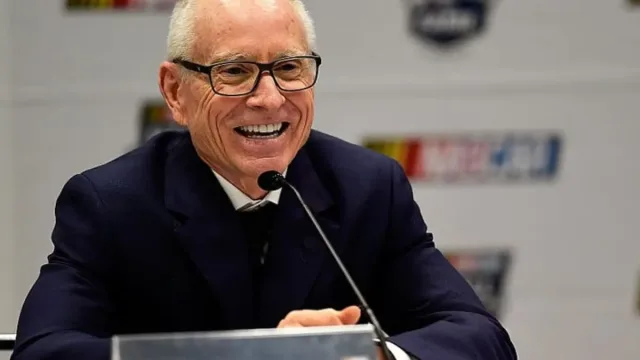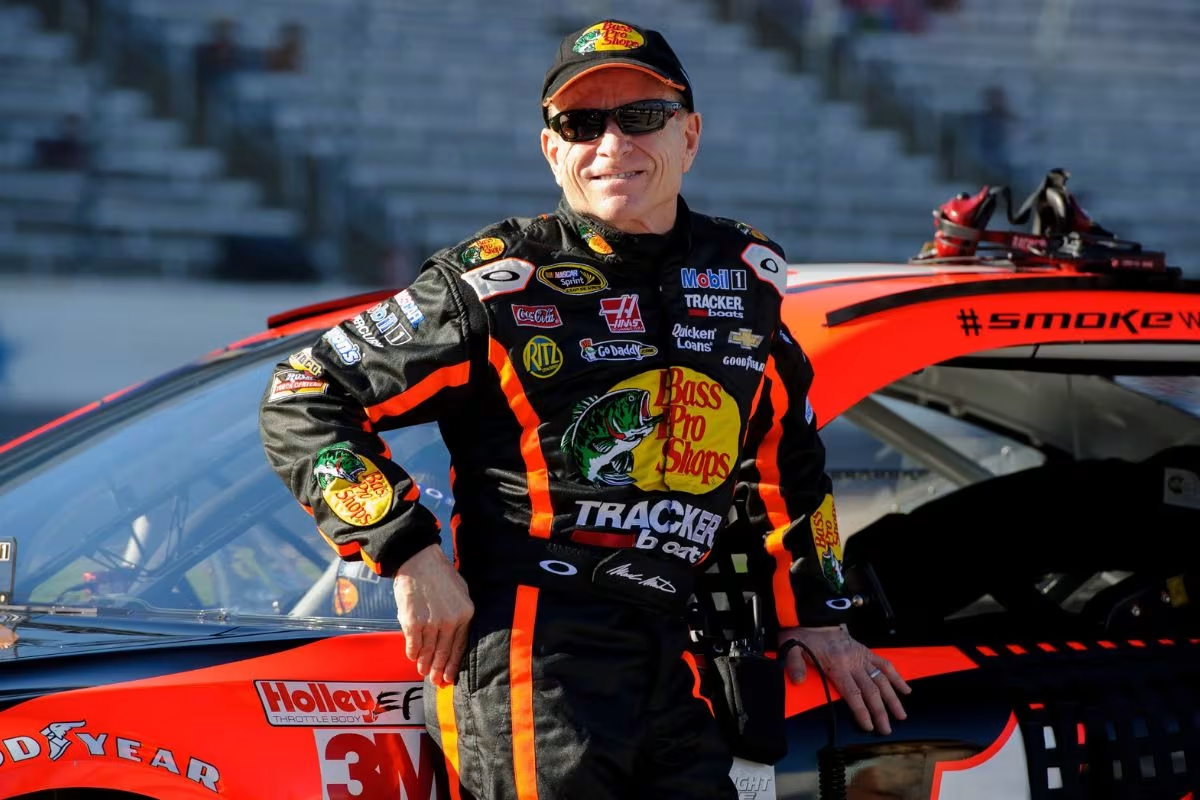Mark Martin Slams Goodyear: Mark Martin has criticized Goodyear for the declining quality of NASCAR tires, asserting that the emphasis on longevity has reduced the grip necessary for engaging racing. He argues that this strategy leads to predictable outcomes, diminishing the excitement and strategy involved in races. The lack of tire degradation has resulted in “stale racing action,” where drivers cannot exploit tire performance for tactical advantages. Martin’s concerns echo a broader sentiment among fans and drivers about tire innovations, evocative of the competitive eras of the past. The evolving tire technology poses questions about its impact on racing dynamics going forward.
Key Highlights
- Mark Martin criticized Goodyear for creating tires with minimal grip, leading to predictable racing outcomes and lack of excitement.
- He expressed concerns about the absence of tire degradation, limiting strategic diversity during races.
- Martin lamented the decline in tire performance compared to the competitive tire wars of the 1990s.
- He called for Goodyear to prioritize performance improvements to enhance the racing experience for fans and drivers.
- The recent introduction of new tire compounds aims to address these issues and improve short-track racing dynamics.
The Controversies Surrounding the Next Gen Car
The introduction of the Next Gen car has certainly sparked numerous controversies within the NASCAR community. Designed to improve parity and foster close racing, the vehicle has instead encountered many issues that have shifted the focus of competition towards track position.
This fundamental alteration has led to a series of reactions from drivers and fans, who are grappling with the implications of such a departure from traditional racing dynamics.
Among the primary concerns is the car’s performance on superspeedways and short tracks, where fuel mileage strategies have become paramount. This reliance on track position compromises the essence of racing, reducing the excitement that comes from overtaking and tactical maneuvers.
The anticipation of thrilling, competitive races has been dulled by the necessity to safeguard track position, ultimately reducing the very objectives that the Next Gen car was intended to achieve.
Although NASCAR has initiated tire experimentation with Goodyear as a potential remedy, these efforts do not assure success. The lack of notable tire degradation during races raises further questions about the car’s design and its compatibility with the unique demands of different tracks.
This situation has elicited pointed critiques from figures like Mark Martin, who lament the decline of tire performance that once provided drivers with tangible grip and tactical options. As these controversies occur, the Next Gen car remains a focal point of scrutiny, demanding solutions that honor the sport’s competitive spirit.
Mark Martin’s Concerns with Goodyear’s Solution
Concerns abound regarding Goodyear’s proposed solutions to the tire issues ruining the Next Gen car, particularly from veteran driver Mark Martin. His skepticism highlights a critical concern: the lack of tire falloff at short tracks, which has fundamentally altered NASCAR racing.
Martin argues that the current tire performance has led to predictable outcomes, diminishing the core of racing strategy that fans and drivers cherish. The absence of tire degradation means that drivers are not incentivized to alter their racing tactics; instead, the focus shifts to maintaining track position.
This stagnation results in what Martin describes as “stale racing action,” where the excitement of tire management and tactical play is replaced by a formulaic execution of laps. Essentially, the race winner often appears pre-determined, stripping away the dynamic nature of competition.
Martin’s concerns extend beyond mere aesthetics; they touch upon the integrity of the sport itself. With the Next Gen car struggling to inspire the same level of gripping races that characterized previous models, the responsibility falls on Goodyear to re-evaluate their approach.
The veteran driver’s insights serve as a call to action for tire manufacturers to prioritize performance that allows for a more engaging racing experience, fostering unpredictability and excitement.
The Tire War and Changes in Goodyear’s Tires Over Time
Mark Martin’s reflections on the current state of Goodyear tires highlight a notable contrast to the era when tire competition defined NASCAR. In the 1990s, particularly during his victory at the 1994 Hooters 500, the introduction of tire wars energized the sport, offering drivers a choice between Goodyear and Hoosier.
This competition not only spurred innovation but also guaranteed that tires performed at an ideal level, yielding a tangible grip that translated into exhilarating racing experiences.
“Look at the hood. Tires were gummy back then. They just make black powder now days.” – (Mark Martin)
Martin’s observation of the rubber degradation on his car’s hood from that era sharply contrasts with the current phenomenon of mere “black powder” accumulating on Next Gen cars.
The decline in tire quality can be attributed to the absence of competition since Hoosier’s exit from the NASCAR scene. With Goodyear as the sole tire supplier, the drive for continual improvement has diminished.
Today’s tires are engineered with a focus on longevity and consistency rather than the aggressive grip that characterized the racing of previous years. This shift has implications not only for driver performance but also for fan engagement, as the thrill of racing is diminished when cars cannot exhibit their abilities on the track.
Moreover, variations in track temperatures, especially during night races, further compound the issue, leading to a lack of responsiveness in tire performance. The evolution of Goodyear’s tires, from the gummy rubber of the past to the current iteration, raises critical questions about the future of competitive racing and the alignment of tire technology with the expectations of drivers and fans.
NASCAR’s Efforts to Solve the Short-Track Package Issue
Efforts to improve the short-track racing experience in NASCAR have become increasingly critical as teams and drivers seek to optimize performance on these challenging circuits. The complexity of tire management has emerged as a focal point, particularly following the varied results of recent races.
After observing the notable tire wear during the Bristol race, which highlighted tactical tire conservation and rewarded veteran drivers, NASCAR recognized the necessity for a more effective tire strategy across other short tracks.
Despite introducing a softer tire compound for the Martinsville race, NASCAR faced mixed results in earlier spring races at Richmond and Martinsville, where the anticipated performance improvements did not materialize.
The All-Star race at North Wilkesboro, although featuring the softer red tire, fell short of expectations, emphasizing the ongoing challenges of creating a consistently competitive short-track package. This pattern of disappointing tire performance prompted NASCAR to reassess its approach.
In a bold move, NASCAR opted for a new tire compound for the playoff race at Martinsville, reflecting a willingness to innovate in response to previous shortcomings. The relative success of this new compound signals a potential turning point in addressing the short-track package issue.
The Success of the New Tire Compound at Martinsville
One notable development in NASCAR’s tire strategy was the introduction of the new tire compound at Martinsville, marking a pivotal moment in the ongoing quest to improve short-track racing. This initiative saw the return of right-side option tires alongside the softest tire compound utilized since the Next Gen car’s beginning in 2022. The results were promising, as the fresh rubber showed exceptional speed while also imposing a tangible wear rate that required drivers to adopt a tire conservation strategy.
“The last 70 or so laps, I tried to save my rear (tires) the best I could, because that’s where I started struggling later in the runs.” – (Ryan Blaney)
Ryan Blaney’s performance serves as a proof of this new dynamic. His ability to execute late-race passes, after methodically saving his rear tires during the final stage, exemplifies how the new compound can influence race strategy. “The last 70 or so laps, I tried to save my rear (tires) the best I could,” Blaney remarked, highlighting the necessity of tire management in optimizing performance.
The collaborative efforts of NASCAR and Goodyear in refining the short-track package appear to be yielding dividends. However, it is vital to approach the success of this tire experiment with cautious optimism.
The true test will arrive when these new tires face the rigors of repeated use on short ovals in the upcoming seasons. Only then can we ascertain whether this initiative represents a breakthrough in tire technology or merely another chapter in the ongoing narrative of short-track challenges.
News in Brief: Mark Martin Slams Goodyear
The ongoing debates surrounding Goodyear’s tire performance and its impact on NASCAR racing highlight notable concerns regarding grip and competitiveness. Mark Martin’s criticisms reflect a broader dissatisfaction with the evolution of tire technology, particularly in the context of the Next Gen car.
While NASCAR endeavors to address these challenges, particularly in short-track racing, the recent success of a new tire compound at Martinsville suggests potential pathways for improvement and renewed excitement within the sport.
ALSO READ: Mark Martin Compares Hamlin-Gabehart Duo to Racing Legends Emphasizing Their Chemistry



